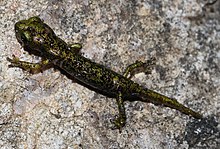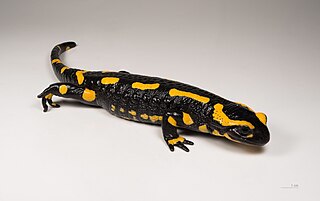
The fire salamander is a common species of salamander found in Europe.

The olm or proteus is an aquatic salamander which is the only species in the genus Proteus of the family Proteidae and the only exclusively cave-dwelling chordate species found in Europe; the family's other extant genus is Necturus. In contrast to most amphibians, it is entirely aquatic, eating, sleeping, and breeding underwater. Living in caves found in the Dinaric Alps, it is endemic to the waters that flow underground through the extensive limestone bedrock of the karst of Central and Southeastern Europe in the basin of the Soča River near Trieste, Italy, southwestern Croatia, and Bosnia and Herzegovina. Introduced populations are found near Vicenza, Italy, and Kranj, Slovenia. It was first mentioned in 1689 by the local naturalist Valvasor in his Glory of the Duchy of Carniola, who reported that, after heavy rains, the olms were washed up from the underground waters and were believed by local people to be a cave dragon's offspring.

Wehrle's salamander is a species of salamander in the family Plethodontidae. It is endemic to the Eastern United States. It is named in honor of Richard White Wehrle (1852–1937), a jeweler, naturalist, and collector of the holotype.

The gold-striped salamander or golden-striped salamander is a species of salamander in the family Salamandridae. It is the only species of the genus Chioglossa. It is found in the north-west of Iberia at an altitude of up to 1,300 m. It is threatened by habitat loss.
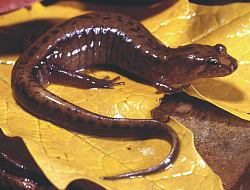
The Allegheny Mountain dusky salamander is a species in the Plethodontidae family native to eastern North America.
The West Virginia spring salamander is a species of troglobitic salamander in the family Plethodontidae. It is endemic to West Virginia, the United States.
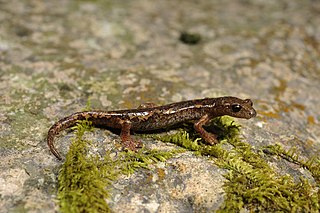
Ambrosi's cave salamander or the Spezia cave salamander is a species of salamander in the family Plethodontidae. Endemic to northwestern Italy, its natural habitats are temperate forests, rocky areas, caves, and subterranean habitats. It is threatened by habitat loss.

The Monte Albo cave salamander or Stefani's salamander is a species of salamander in the family Plethodontidae, endemic to Sardinia.
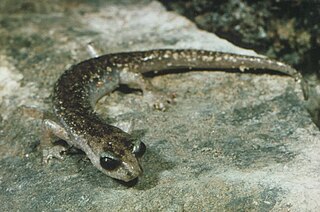
The brown cave salamander, also known as Gene's cave salamander, Sardinian cave salamander, or simply Sardinian salamander, is a species of salamander in the family Plethodontidae. It is endemic to Sardinia (Italy). Its natural habitats are temperate forests, rocky areas, caves, and subterranean habitats. It is threatened by habitat loss.

The Italian cave salamander is a species of salamander in the family Plethodontidae. Endemic to Italy, its natural habitats are temperate forests, rocky areas, caves, and subterranean habitats. It is threatened by habitat loss.

The Supramonte cave salamander is a species of salamander in the family Plethodontidae, endemic to the island of Sardinia (Italy).
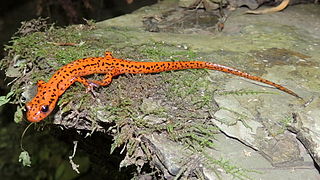
The spotted-tail salamander, also known as a "cave salamander", is a species of brook salamander.

The fauna of Italy comprises all the animal species inhabiting the territory of the Italian Republic and its surrounding waters. Italy has one of the highest levels of faunal biodiversity in Europe, with over 57,000 species recorded, representing more than a third of all European fauna. This is due to various factors. The Italian peninsula is in the centre of the Mediterranean Sea, forming a corridor between central Europe and North Africa, and it has 8,000 km (5,000 mi) of coastline. Italy also receives species from the Balkans, Eurasia, and the Middle East. Italy's varied geological structure, including the Alps and the Apennines, Central Italian woodlands, and Southern Italian Garigue and Maquis shrubland, also contribute to high climate and habitat diversity.
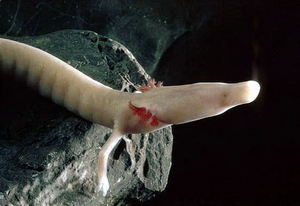
A cave salamander is a type of salamander that primarily or exclusively inhabits caves, a group that includes several species. Some of these animals have developed special, even extreme, adaptations to their subterranean environments. Some species have only rudimentary eyes. Others lack pigmentation, rendering them a pale yellowish or pinkish color.

Speleomantes strinatii, the French cave salamander, North-west Italian cave salamander, or Strinati's cave salamander is a small species of salamander found in northwest Italy and southeast France. It is very similar in appearance to the Italian cave salamander, but has a paler belly.

The Sarrabus' cave salamander or Sette Fratelli cave salamander or, is a species of salamander in the family Plethodontidae. It is found in southeastern Sardinia, east of Cagliari. The species was thought to have been a part of Speleomantes imperialis but was found to be a separate species.
